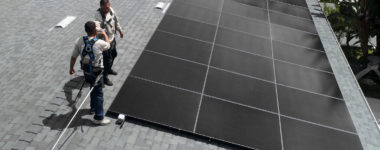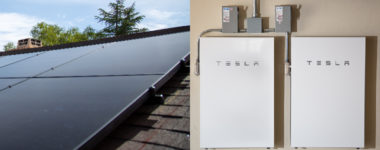Solar Energy | Solar Panels, Battery Storage, Roofing, HVAC
While there are plenty of energy options available to consumers, solar energy is emerging as one of the most effective. Energy harnessed from the sun’s rays is unique in that it is essentially “clean,” providing homeowners, schools, businesses, and all types of facilities with a renewable source of energy. California is one of the leaders in solar power production. In fact, it is leading the nation in number of projects installed, currently sitting at 842,977. California Legislature has even proposed that all of the state’s electricity resources come from renewable energy by 2045. What does this mean for homeowners considering their energy options? As solar power continues to become a priority for California, the incentive to switch to solar grows more and more. Fossil Fuels vs. Solar Energy So what about the old, still heavily used energy source, fossil fuel? Most commonly, fossil fuels refer to natural gas, coal, and oil. Collectively, these fossil fuels have accounted for a majority of the earth’s energy usage. Drilling for these natural resources can be costly and damaging to the earth’s surface, water sources, and more. Not only that, but we are coming dangerously close to depleting many of our main sources of fuels. That means either investing a significant amount of time and money mining for additional resources or finding a new source of energy. At the end of the day, no matter how useful we’ve found fossil fuels in the past, society cannot ignore the fact that fossil fuels create serious pollution. Fossil fuels are not renewable and take much longer to form vs. the rate we are using them. What exactly does the pollution problem look like? Around 21.3 billion tons of CO2 every year, which is considered to be a global warming contributor by scientists. Solar Changes the Energy Game Solar power is changing the game though. By converting sunlight into electricity through solar panel systems, people all over California (and the country) have access to a much cleaner source of energy. But how do we get the equipment to harvest the sun’s power? It is true that solar panels are manufactured using some fossil fuels at this point, however, it is a very minimal amount compared to utilizing fossil fuels for all electricity needs. As PV panel prices continue to drop and more innovation drives the way solar panels are manufactured, the process will get much cleaner. Not only that, but the financial advantages of switching to primarily renewable energy (both wind and solar) significantly outweigh the expense of harvesting and using fossil fuels in the long-run. In comparison with other renewable energy sources, solar power is the most accessible for homeowners. Panels can affordably be installed based on a family’s budget, home size, and overall electricity needs. This means a clean earth has never been more accessible and affordable to our modern world. So why wait? Find out how you can make the switch to solar today. Contact Semper Solaris to learn more about our team and our solar options.
Semper Solaris is proud to be one of the top solar installers in Southern California. The demand for solar panel systems has never been greater; however, that also means the demand for information and insight on solar energy is also in high demand. We understand that homeowners have lots of questions before diving into the solar energy world – ranging from how much panels cost to how they actually work – which is why we strive to provide all the info they need to make informed decisions. Fact #1: Solar Energy Is Free & Abundant Coming from the powerful rays of the sun, solar energy is a free resource available across the globe. The only costs come from actually harvesting the power of the sun, such as manufacturing, installing, and maintaining a solar panel system. Even still, the fact that the sun is readily available to produce solar energy throughout the day is a reassuring fact in light of the depleting nature of fossil fuels. Fact #2: Solar Is Growing to a Favored Energy Source Solar energy has many advantages and long-term benefits for the planet as a whole. Due to its minimal impact, solar is considered one of the most popular renewable energy sources. Because of this, solar has grown to be a leading renewable energy source, with states like California pushing to be completely renewable energy dependent in less than 30 years. Fact #3: Solar Is a Non-Polluting Energy Source Not only is solar energy considered one of the top sources of renewable energy, but it also counteracts the Greenhouse effect on the earth’s climate. The recent global warming issue is thought to be caused greatly by human’s significant use of fossil fuels. In fact, solar energy doesn’t produce any pollution, which means it doesn’t harm the environment like other energy sources do. While there are other renewable energy sources on the market, solar energy is one of the most broadly accepted and used as technology continues to be developed for converting solar energy into electricity. Fact #4: Solar Panels Are Basically Maintenance Free Unlike other home applications, solar panels require little to no maintenance, making them a hassle-free energy source. Solar panels convert power and send it to batteries that don’t need any service or tune-ups, allowing them to last for years with minimal work. Further, once a homeowner has had their solar panels installed and paid for, there are basically no recurring expenses. Fact #5: The Price of Going Solar Is Becoming More Affordable When solar energy was first introduced, it was used by limited groups. Now, countless homeowners across the country have solar panels installed on top of their homes, allowing them to harvest the power of the sun on a daily basis. As the technology continues to improve and advancements are made in the conversion and storage of renewable energy, the cost of having solar panels installed will continue to become more attainable for homeowners and business owners alike. Solar also helps cut down expenses for homeowners, reducing electricity bills and giving them more control.
There has been a rising interest in solar battery storage in recent years. While most homes are still tied to power grids, a solar battery like Tesla Powerwall would allow homeowners to move closer to being “off the grid” for good. For most, the allure of complete autonomy when it comes to electricity production and usage is very enticing. One of the biggest perks of having a solar panel system is to provide more self-sufficiency, after all, and a solar storage battery is just another step towards independence from utility companies that continue to hike electricity prices. That is why we are going to take a look at the benefits and pitfalls of both traditional grid-tied solar power systems and solar power systems backed by battery storage. How Does a Grid-tied Solar Power System Work? Having a solar power system for your home gives you much more control over your electricity usage. You are able to harness the power of the sun and convert it into usable energy, majorly cutting back on utility expenses. But will solar panels produce enough power for your home? What about those times when the sun doesn’t shine through the clouds or a stormy day hampers energy production? For most homeowners, the solution is being tied to a power grid. For any energy demands they have that their solar production doesn’t cover, they will start pulling from the power grid instead. Even though homeowners essentially have to “buy” energy during these times, they often have credits to cover the expenses. This means that during evening hours without sunlight, cloudier days, or other circumstances, homeowners can still ensure their electricity needs are covered -- and still benefit from previous over-production of electricity needs. In some states, homeowners can even earn money for any additional electricity their panels have produced that they don’t use from the grid. There is also great assurance knowing that there will always be some source of power to pull from should a home’s solar panels not provide the electricity needed. As states continue to adopt models for charging solar panel customers, power companies stand to benefit the most from having customers still tied to the grid. This also means that the threat of facing time-of-use rates and other spikes in utility costs is still very real for homeowners with a grid-tied solar power system. How Does a Battery Storage Solar Power System Work? In theory, a solar power system that has a solar storage battery could be completely grid-free. That means homeowners have ultimate control over their electricity needs. They don’t have to worry about using credits to cover additional energy demands during low production hours, time-of-use rates, or other challenges that come with a regular grid-tied system. Battery technology isn’t new, but using batteries for home solar power storage is still not widespread yet. However, the interest in energy storage is growing greatly. As products continue to be developed, the efficiency and storage capacity of these batteries will continue to improve. However, some home electricity demands would still exceed the storage capacity of a solar battery. If you tried to go completely “off the grid,” you could be left without power once you depleted your backup resource until the sun comes back out. Why a Hybrid System Is Gaining Popularity It is clear that both a grid-tied system and battery-backed system boast plenty of perks – and challenges alike. Instead of weighing the pros and cons to the point of pulling out your hair, consider an alternative solution: a hybrid system. A hybrid solar power system can include the pros of both sides, while essentially eliminating the cons. A home can have the perks of being tied to the grid for any energy needs they have once they’ve used up their solar panel production and battery storage. Homeowners have the ability to draw electricity from both their local power grid, as well as from their home solar batteries. They can choose to invest in more solar batteries for more independence overtime or simply get one for backup purposes. Having a hybrid system also gives homeowners more flexibility and control. They may choose to reserve their solar power storage for emergency usage only, after the sun goes down, or as backup in case electricity prices surge during certain hours of the day. Combining a grid-tied system and battery system allows for a consistent and more controlled flow of energy throughout the day and night for homeowners. When is a hybrid system the most desirable? For homeowners who live in an area without favorable compensation rates for excess electricity produced by solar panels, having a hybrid system can be crucial. Rather than simply sending excess electricity to the grid at a low rate, a homeowner can save some of that valuable electricity for future use, only sending what they don’t use or store. How California’s Net Metering Policy Has Changed Homeowners who live in California may be even more inclined to consider a hybrid solar power system. Net Metering 2.0 (NEM 2.0) is an update to California’s original policy on net metering, now including time-of-use rates, non-bypassable charges, and some additional fees. The estimated additional cost will jump up to around $10/month for an average homeowner. The time-of-use rates will be the biggest adjustment for many homeowners, which will adjust the credit given for solar electricity depending on the time of day it was produced. Typically, any excess electricity that is sent back to the grid during higher demand or peak hours will be given more credit. Overall, the policy is still favorable for homeowners, but having a solar battery to store excess electricity can provide more flexibility to bypass lower time-of-use rates and send by electricity during those peak value hours. Whether you are considering completely disconnecting from your local power grid with solar storage batteries or just want to create the most efficient home solar power system, talk to Semper Solaris about your battery options today.


